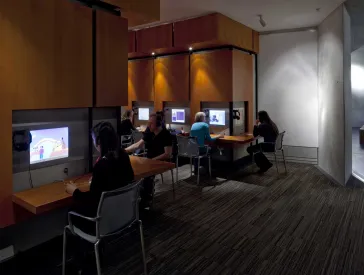Obituary for Coco Schumann
14 May 1924–28 January 2018
The Jewish Museum Berlin grieves the loss of Coco Schumann. The guitarist and jazz musician passed away on 28 January 2018y at the age of ninety-three years old. Coco Schumann frequently performed as part of the Cultural Summer program, and his relationship with the Jewish Museum Berlin reaches back to its founding. For a long time, Coco Schumann’s life story could be retraced in the Rafael Roth Learning Center. It exposed museum visitors to a childhood cut short by National Socialist oppression—and a musical talent that granted young Schumann moments of self-assertion in the Berlin jazz clubs ostracized by the Nazis. This talent would also save his life in Theresienstadt and Auschwitz.
Coco Schumann at the multimedia Rafael Roth Learning Center in 2002; Jewish Museum Berlin, photo: Jo Diener
In May 1924, Heinz Jakob Schumann was born to a Jewish mother and Christian father. He received the name Coco later from a French girlfriend who was at a loss for how to pronounce the “H” in Heinz. Liberal Judaism was among the formative influences of his early years, as were Christian traditions:
“The Christmas tree stood next to the Hanukkah menorah. We celebrated Easter with my father’s parents and Pessah with my mother’s parents. The family didn’t differentiate much between them, which I thought was ideal, even back then.”
With the introduction of the anti-Semitic Nuremberg Laws in 1935, Heinz Schumann was labeled a “Geltungsjude”, someone who was deemed Jewish but did not previously fit into a legal category defining them as such. He had to leave public school and attend a Jewish school, and his mother had to close her hair salon.
Nightlife and music opened worlds beyond this hostile reality. Heinz Schumann discovered his love of jazz through his uncle Arthur Rothholz, who played drums with his “gypsy band” at the Prater in Berlin. The Nazis considered the sound of the era to be an “inhuman evil.” At first, it wasn’t prohibited because the capital city was supposed to seem cosmopolitan for the 1936 Olympics. Heinz Schumann first received guitar lessons from his German teacher, but later he became a self-taught virtuoso.
Beginning in 1939, Heinz Schumann performed forced construction labor. Despite his hard work by day, by night he was drawn to the bars. On New Year’s Eve 1939/40, he had his first paid performance as a drummer at the Hasenschaukel in Charlottenburg. That’s when he received his stage name and Heinz became Coco. Soon he was earning good money with his music. In the Rosita Bar in Schöneberg, he played with Tullio Mobiglia’s orchestra, a city-wide heart-throb. As his success grew, Coco Schumann’s performances became ever more dangerous. As a Geltungsjude, he was not a member of the Reich Chamber of Culture and was not allowed to perform in public. And especially not the English and American “music of the enemy,” which had been banned by then. Coco Schumann risked hiding his “star” in his pocket at the bars.
In March of 1943, he was denounced and sent to the Theresienstadt ghetto. There, he joined the Ghetto Swingers jazz band, formed by Czech trumpet player Erich Vogel. At first, the music kept Coco from being deported to an extermination camp. The National Socialist ghetto administration wanted cultural activities in order to maintain the outer appearance that Theresienstadt had a “normal” cultural scene.
On 24 September 1944, Coco Schumann was transported to Auschwitz-Birkenau. Coco Schumann and other members of the Ghetto Swingers were forced to play for the SS guards on the instruments of Sinti and Roma people who had just been murdered. They were commanded to play when the guards were inducting people into the camp, when they were off duty, and as they forced people into the gas chambers.
As Soviet troops approached, Coco Schumann was deported from Auschwitz to a satellite of the Dachau camp. The camp was dispersed in April 1945. The prisoners were sent on a death march toward Lake Starnberg. Gravely ill, Coco Schumann was liberated by American soldiers.
Soon after the end of the war, swing music returned to Germany. Coco Schumann was there from the start, taking the stage with Helmut Zacharias and with his “Coco Schumann Combo.” He also made his his first records. He was the first musician in Germany to play an electrically amplified guitar. However, he didn’t trust the country’s political climate.
In 1950, Coco Schumann and his family emigrated to Australia. Four years later, he returned, playing in dance, radio, and television bands. In the 60s and 70s, bars and dance halls lost interest in jazz. Coco Schumann began to take on jobs as an entertainer. He sailed the seas as a musician on a ship and contributed to a Heinz Erhardt film. At some point, he decided to completely dedicate himself to jazz once again. He founded the Coco Schumann Quartet, which he performed with until recently.
“The direction was clear: back to my roots, back into the world where my soul is at home, into swing. Into these mysterious yet simple vibrations that unite musicians and make sparks fly over the audience, that make everyone who feels them part of the whole, regardless of who they are or where they come from.”
Citation recommendation:
Jewish Museum Berlin (2018), Obituary for Coco Schumann. 14 May 1924–28 January 2018.
URL: www.jmberlin.de/en/node/10256

